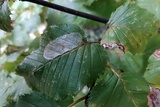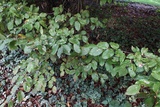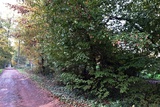Phyllonorycter esperella (Goeze, 1783) Species
Last modified: Dec. 10, 2025, 4:52 p.m.
A rather common species throughout Belgium, but never in great numbers.
Details
- Classification
- Family: Gracillariidae > Subfamily: Lithocolletinae > Genus: Phyllonorycter > Species: Phyllonorycter esperella
- Vernacular names
- Haagbeukblaasmijnmot (NL), Dark hornbeam midget (EN), Oberseitige Hainbuchen-Faltenminiermotte (DE)
- Synonyms
- Phyllonorycter quinnata (Fourcroy, 1785) and Phyllonorycter carpinicolella (Stainton, 1851)
- First mention in Belgium
- Fologne E. 1859b. Supplément au catalogue des lépidoptères de Belgique. — Annales de la Société entomologique belge 3: 133–142. On page 141 (as carpinicolella). view page
- Status
-
Native
Distribution
Imago
Head white mixed with some brown hairs; forewing ground colour golden brown, pattern pure white: a rather long, straight basal line, four costal and three dorsal striae, the first ones prolonged towards the basis of the wing.
Museum specimens
No pictures yet!Specimens in nature
No pictures yet!Caterpillar
The caterpillars of the sap-feeding instars are whitish green with conspicuous black markings on the dorsum of each segment. In the tissue-feeding instars, these black markings are absent and the ground color turns to a shade of yellow, head capsule brown.
Mine
At first a semi-circular or oval tentiform mine on the upperside of a leaf, whitish with a silvery hue, situated on the main vein or a secondary vein. In later stadia this mine is enlarged to a longer mine between two veins contorting the leaf upwards, sometimes completely covering the mine. In rarer cases, especially with smaller leaves, the leaf is completely folded upwards.
See also gracillariidae.net and bladmineerders.be.
Bionomics
The last instar spins a white cocoon in the mine and it pupates inside this cocoon.
The species hibernates in the pupal stage in the mine, among the fallen leaves between leaf litter.
The adults rest during the day but they become active at dusk and come to light.
Flight periods
Two generations a year in May and August.
Observed on
- Host plant (species):
- Carpinus betulus
The species lives mainly on Carpinus betulus, but it has also been recorded on Ostrya carpinifolia, which is often planted in gardens and parks as an ornamental plant.





